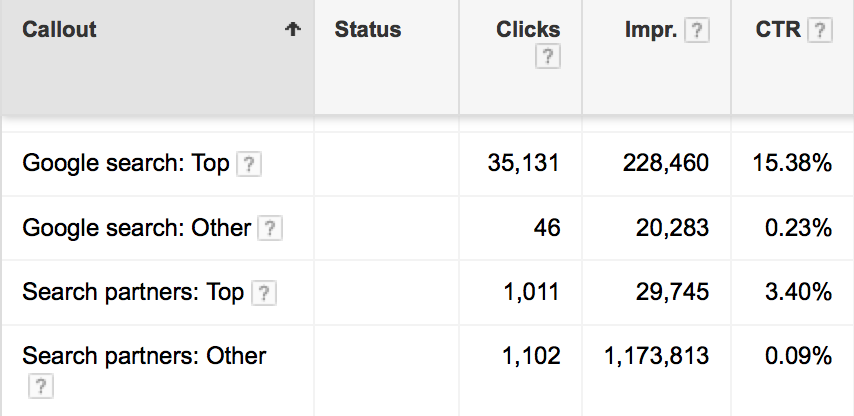Ad extensions are touted as an important component of any PPC account. The AdWords system even rates your ads based on the use of ad extensions. Beyond the “use them or suffer” reasoning, extensions offer a great way to differentiate your ads or are simply a way to take up more real estate in the search results.
Despite their visibility, there remains a constant doubt to the source of their actual value. Taking a look at the “this extension vs. other” option in AdWords, you’ll notice interactive extensions such as sitelinks are rarely clicked. Even further removed we have callouts and structured snippets that can’t be interacted with at all.
Thankfully, we can move beyond the basic interface to get a better picture. Today we’ll cover a simple use case. It should provide you with an impetus to evaluate your own accounts and extensions in a slightly more thorough fashion. With all the emphasis on ad testing, we should, at least, consider extension copy as well.
Basic Considerations
First, we must consider what we are looking for. Are we looking for data on extensions across all AdWords efforts, looking to see the effect on top of page positions, or trying to gauge the impact of extensions on the search partners? Extensions are slightly trickier than basic ad analysis because they won’t always show and are subject to the algorithms’ current choices.
Clarifying your intentions up front allows you to make better conclusions and measure the right thing. It also limits the variables in your favor.
For example, consider a campaign that accumulates 3 times the impression count on search partners with fewer clicks. This would throw off your average CTR in comparison to campaigns without the impression bloat. If you include these numbers while intending to evaluate the search network, you’ll only muddle your analysis.
Through the rest of the article, we’ll focus on top of page ads on the Google Search Network. This will remove any inconsistencies from the search partners and allow us to examine the difference in performance at the top of the page.
Obtaining The Data
Pulling the data is easy once you know what you are looking for. In this example, we need to pull a callout extension report, segmented by top vs. other. Then we will pull a campaign report segmented by top vs. other. You might wonder why we aren’t segmenting by network but the report segments the networks as well.
We want to make sure to use the same segments for the ad extension and general performance. Mismatches will not only throw off your ratios for how often ads show, but metrics like CTR can dramatically differ based on positioning.
Once you’ve downloaded the reports, delete the search partners and “others” – which out of context sounds ominously prejudiced.
Once we have the data we can start putting together something more readable. Create a sheet with your filtered extension metrics. You can include any other metrics you are interested in.
Now that we have the extension metrics, we need to compare them to the campaign metrics. The easiest way to line these up is with a friendly vlookup or index match.
Drag and drop those formulas and we can move on to the interesting part.
Putting It Together
How often does a particular extension show? Easy, we divide the extension impressions by the campaign extension impressions to arrive at a “show rate.” The more an extension shows the more likely it is that any top position ad is adorned with the callout extension.
Next we can take a look at the relative CTRs. How does the CTR differ when the extension shows compared to the average CTR? Unfortunately, we can’t separate the impressions where an extension showed from the instances where an extension did not show. As such, when you see high show rates, you can expect the CTRs between the two to be closely aligned.
Nonetheless, we see a lift when the extension shows. As expected, the ads perform at least a little better than average in most situations. If we assume that AdWords is running their own optimizations and selecting which extensions to show, we can assume that higher show rates are considered better extensions.
Show rate is dependent on many factors so the best you can hope for is comparing show rates within the same ad group or campaign. Any wider ranging conclusions would be suspect to say the least.
Further Thoughts
We only looked at one specific case today. It’s worth examining the different networks, placements, and additional metrics. Moving down to the ad group level can shed light on the inconsistencies within a campaign. By creating better extensions at the ad group level, you ensure your high priority ad groups have the right combinations for that set of ads and keywords.
While this can’t completely guide your strategy for extensions it can shed light on ad performance and move you past “just choose whichever one has the higher CTR.” While the value of ad extensions is often more about their existence than creativity, reports like these can provide that extra bit of polish to your work.







